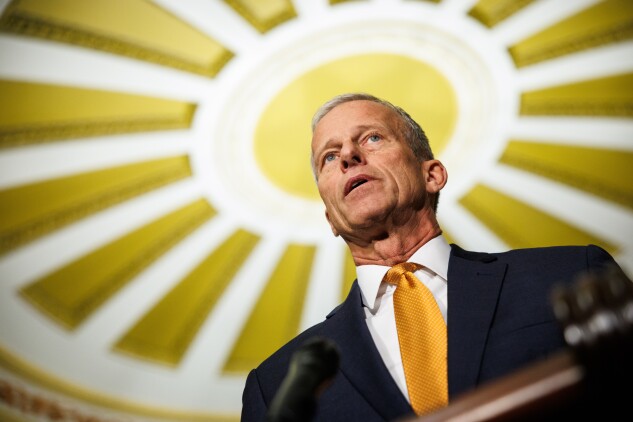The End is (Finally) Nigh
Sometimes nothing focuses the mind quite like having to work on a weekend.
After forcing senators to stay in town, Republican Senate Leader John Thune finally got his deal, convincing enough moderate Democrats to break from the rest of their party.
In a 60-40 test vote that was held up for hours as the chamber awaited Sen. John Cornyn (R-Texas), the Senate indicated there was enough support for a compromise that will reopen the government after the longest shutdown in history.
Under the agreement, Congress will pass full-year funding for the departments of Agriculture, Veterans Affairs and Congress itself, while funding other agencies through Jan. 30. The bill would provide pay for furloughed government workers, resume withheld federal payments to states and localities and recall agency employees who were laid off during the shutdown.
The measure doesn’t extend health care subsidies, the main sticking point that Democrats had been holding out for. There was only the promise of a future vote on the issue.
All of the Senate Democrats who support the deal are either retiring or aren’t up for re-election next year. Those who didn’t support it were quick to criticize: Bernie Sanders (I-Vt.) called the promised health care vote “a totally meaningless gesture.”
House Democrats also attacked, but they have fewer tools to derail the agreement. A final vote could come this week. More details are in Congress Tracker.
Also Read:
- BGOV Bill Analysis: Stopgap Funding to Jan. 30 & Minibus
- US Flight Delays Set to Escalate on Chicago Snow, Tighter Limits
- Trump Administration Loses Bid to Limit Food Aid Funding for Now
Judicial Nominees Speed to Hearing Dates
President Donald Trump’s judicial nominees are not having to cool their heels in the spotlight for very long.
In a break from norms, the administration is leaving very little time between announcing its choices and those nominees getting hearings before the Senate Judiciary Committee. In some cases, only two days elapsed between the White House’s announcement and the committee hearing.
That narrow window is cutting short the time outside groups have to vet these lifetime appointments.
In prior administrations, there was typically 28 days between a White House announcement and a hearing date. That’s the minimum amount of time the Senate requires between when it receives background information. The Trump administration is giving the committee advance notice before publicizing picks.
The committee said it “does not control when the White House formally announces judicial nominees.”
Trump supporters see no gamesmanship. “They’re putting people out when they clear background, and they’re trying to get as many people on hearing slates as they can so that we can keep a steady stream of nominees going to the Senate,” said Robert Luther, a former White House lawyer who worked on Trump’s first term judicial nominations.
Others raised concerns. The current trend line “seems a lot more like a conscious decision to keep this as a secret for as long as possible,” said John P. Collins, a George Washington University law professor. Read More
How Well Do You Know Washington — Veterans’ Edition
During the shutdown, the Department of Veterans Affairs has continued to pay its contractors. Which of these big-spending civilian arms of the government sent more dollars to vendors in October than the VA?
A) Energy
B) Homeland Security
C) Transportation
D) All of Those
E) None of Those
Scroll down for the answer.
Shutdown’s ‘Eco Fog’ Is Getting Worse
The shutdown is making it harder to get a read on what’s actually happening in the economy. Two monthly jobs reports have fallen victim to the closure and a key inflation snapshot due in the coming week is also in jeopardy.
The Bureau of Labor Statistics was scheduled to report the October consumer price index on Thursday, yet the government’s closure has not only delayed its release but also halted in-person data collection. It’s increasingly likely the BLS will forgo issuing an October CPI report altogether, obscuring the rate of inflation.
All of this missing data only complicates an already divided Federal Reserve as it prepares for another rate meeting in December. Even a swift re-opening may not solve all the data gaps. Read More
Also Read:
- It’s Trump’s Economy Now and Americans Don’t Seem to Love It
- US Ports Facing ‘Goods Recession’ Amid Holiday Lull, Tariff Woes
Did You Ace the Quiz?
Contracting analyst Paul Murphy ran the numbers. The civilian department spending the most during the shutdown’s first month was Veterans Affairs ($3.8 billion), so give yourself a star if you chose Option E — None of Those.
Before You Go
Abbott Wants More: Texas Governor Greg Abbott (R) said he’ll run for reelection, unveiling an unprecedented bid for a fourth term leading the second-largest state in the US. Read More
‘War’ on Judges: Todd Blanche, second-in-command at the Justice Department, called on young conservative lawyers to join the department’s “war” against activist judges. Read More
Fiserv’s Swoon: Senate Democrats are seeking more information on what role former CEO (and current IRS and Social Security head) Frank Bisignano played in the plunge of Fiserv. Bisignano dodged a roughly $300 million loss because he divested his stake in the company before October’s downturn. Read More
Elevating Hispanic Candidates: Hispanic Democrats are pushing their party to be more aggressive in boosting Latino candidates who are facing competitive primaries for House seats this cycle. Read More
Add Us To Your Inbox
To get Starting Line for free on weekday mornings, sign up here.
To contact the reporters on this story:
To contact the editors responsible for this story:





